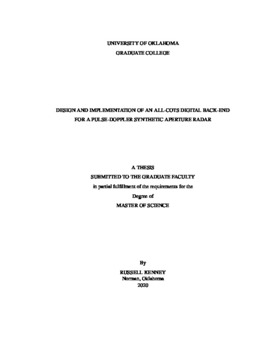| dc.description.abstract | Radar imaging techniques employing synthetic aperture radar (SAR) are ubiquitous in applications such as defense, remote sensing, space exploration, terrain mapping, and many others. However, to obtain fine image resolution, radar systems must be capable of utilizing large signal bandwidths. By the sampling theorem, a large signal bandwidth equates to a high sampling frequency, resulting in more expensive and complex digital electronics required to digitize and process the waveform. Using linear frequency modulated (LFM) pulses and stretch processing techniques, systems such as frequency-modulated continuous-wave (FMCW) radars reduce the required sampling rate at the expense of longer pulses, higher transmit duty cycle, and decreased pulse repetition frequency. While these tradeoffs are often acceptable, in many situations they are not, and a pulse-Doppler radar system is required. These systems can utilize LFM pulses with nearly any desired pulse length and pulse repetition frequency to perform imaging, but they must have an analog-to-digital converter (ADC) and back-end processing capable of handling the full waveform bandwidth, leading to increased cost, size, or both.
At the University of Oklahoma’s Advanced Radar Research Center, a pulse-Doppler radar system for use in a SAR application is designed and built using only commercially available components to decrease the size and cost of the radar, specifically the digital back-end. A minimum size and weight is targeted for this system because it is desired to eventually fly the radar and form images on a lightweight airborne platform, such as a quad- or octo-copter. The challenge with using commercial parts for a custom digital pulse-Doppler radar is that it is difficult to meet the strict timing requirements inherent to pulse-Doppler radar while simultaneously meeting the high-bandwidth requirements imposed by SAR. In this thesis, the design and implementation of the digital back-end for the custom SAR system is presented. The focus is placed on designing a control system and clock distribution scheme in the digital back-end to ensure pulse to pulse coherence while maintaining ideal LFM spectral quality. Additionally, a calibration method is devised to provide accurate range measurements each time the radar is turned on even if the latency between the digital transmitter and receiver changes. At the conclusion of this work, it is shown that the radar system is capable of performing accurate pulse-Doppler radar through the generation of range-Doppler maps from data captured by the radar. The results of these tests indicate that the system is suitable for eventual use in SAR imaging applications. | en_US |

